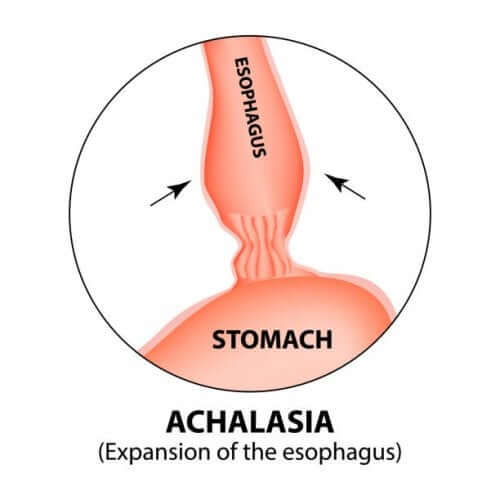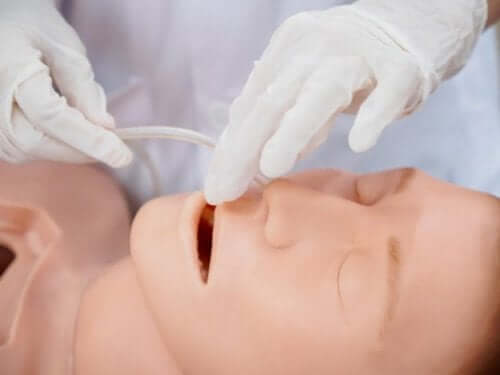Esophageal Achalasia: Symptoms and Treatment

Esophageal achalasia is a rare disorder that can appear at any age. Its main symptom is the inability of the esophagus to dilate and allow food into the stomach.
Undoubtedly, this is a big problem. Despite all of the research on it, the scientific community hasn’t been able to find the specific causes for it yet.
However, what they did discover is that it afflicts both men and women and that it doesn’t seem to be genetically transmitted.
Symptomatology of Esophageal Achalasia

For a doctor to diagnose this disease, they should pay attention to the symptoms.
- Dysphagia: This is difficulty swallowing both solid and soft foods, as well as an inability to drink liquids. It’s mainly due to a contraction in the upper part of the esophagus.
- Chest pain: This doesn’t happen frequently, but it could occur if there are contractions in the lower esophageal sphincter.
- Regurgitation of food: Some people afflicted by Esophageal achalasia regurgitate the food they digest. This is due to their inability to swallow it.
- Weight loss: When a person can’t get food into their system, they progressively lose weight and it often leads to anemia.
It’s important to know that the foods and liquids that fail to pass through the esophagus and aren’t regurgitated can go into the lungs. This can happen at any moment, even when a person is asleep. Furthermore, the consequences may range from respiratory infections to aspiration pneumonia.
For this reason, you should see a doctor as soon as possible if you suspect you have dysphagia.
How is it diagnosed?
Once a patient presents the aforementioned symptomatology, then it’s necessary to perform some specific tests before establishing a correct diagnosis.
The two most common ones are:
Esophageal Motility Study

An Esophageal motility test is performed with a thin probe inserted through the nose intended to reach the esophagus and the stomach. It’s an uncomfortable procedure so the subject is usually numbed with local anesthesia.
Timed Barium Esophagogram
This is another way to diagnose Esophageal achalasia. It’s a simple test in which the subject drinks a barium liquid previous to the appointment.
Then, the patient stands with their back against an x-ray table. The subject must drink more fluids and, at times, hold their breath for brief moments. This allows doctors to examine the area.
Discover: Relieve Symptoms of Oesophagitis with Five Natural Remedies
Treatments for Esophageal Achalasia

Treatments for this condition often depend on the severity and specific characteristics of an afflicted person. This includes factors such as age, possible respiratory tract infections, etc.
Some of the available options are:
- Balloon dilation: a balloon is inserted into the esophageal sphincter and inflated to keep the esophagus open and enlarged. Normally, this treatment requires repetition once in a while.
- Botox: This is a muscle relaxant injected through an endoscope into the esophageal sphincter. It’s usually done in older people who can’t undergo surgery.
- Muscle relaxants: This treatment requires drugs that relax the muscles before eating. However, the problem with this treatment is there are many side effects.
- Surgery: This is the best option of all, especially for young patients. It’s an effective solution to a problem whose causes are still unknown.
Conclusion
If you present any problems swallowing food or even water, you need to see a doctor immediately.
However, there are times when we may confuse difficulty swallowing with symptoms of anxiety. Nevertheless, it’s always better to be certain by receiving a proper diagnosis.
This will allow you to start a treatment that’s effective in your specific case. Moreover, you’ll prevent major problems due to the pulmonary aspiration of food or liquids we mentioned above.
Currently, there’s still active research conducted on the subject to determine the root causes of Esophageal achalasia. We hope there’ll be a way to prevent this disorder soon.
All cited sources were thoroughly reviewed by our team to ensure their quality, reliability, currency, and validity. The bibliography of this article was considered reliable and of academic or scientific accuracy.
- Carballo, Fiorella Ferrandino, & Brenes, Alberto Alonso Umaña. (2016). Acalasia como trastorno de la motilidad esofágica. Medicina Legal de Costa Rica, 33(1), 269-274. Retrieved January 30, 2019, from http://www.scielo.sa.cr/scielo.php?script=sci_arttext&pid=S1409-00152016000100269&lng=en&tlng=es.
- Carmona Domínguez, Roberto. (2007). Diagnóstico de acalasia esofágica en la atención primaria de salud: Presentación de un caso. Revista Cubana de Medicina General Integral, 23(1) Recuperado en 30 de enero de 2019, de http://scielo.sld.cu/scielo.php?script=sci_arttext&pid=S0864-21252007000100017&lng=es&tlng=es.
- Csendes J, Attila, Braghetto M, Italo, Burdiles P, Patricio, Korn B, Owen, & Salas F, Juan E. (2012). Tratamiento quirúrgico de la acalasia esofágica: Experiencia en 328 pacientes. Revista chilena de cirugía, 64(1), 46-51. https://dx.doi.org/10.4067/S0718-40262012000100008
- Errázuriz B, Juan Ignacio, & De Barbieri IW, Francisca. (2013). Acalasia en paciente pediátrico: Reporte de caso clínico y revisión de la literatura. Revista chilena de radiología, 19(4), 174-176. https://dx.doi.org/10.4067/S0717-93082013000400006
- Jiménez, J. R. J., Domínguez, L. P. I., & Reyes, K. C. (2013). Acalasia congénita; a propósito de un caso. Revista Mexicana de Pediatría, 80(4), 146-149.
- Orgaz Gallego, Mª Pilar. (2009). Achalasia: un trastorno de la motilidad esofágica, no tan raro. Revista Clínica de Medicina de Familia, 2(6), 305-308. Recuperado en 30 de enero de 2019, de http://scielo.isciii.es/scielo.php?script=sci_arttext&pid=S1699-695X2009000100010&lng=es&tlng=es.
- LEÓN A, PAULA, CSENDES J, ATTILA, BRAGHETTO M, ITALO, LASEN DE S, JOSÉ, & ROBLES M, JOSÉ. (2010). Acalasia en obesos mórbidos: Reporte de casos. Revista chilena de cirugía, 62(2), 172-174. https://dx.doi.org/10.4067/S0718-40262010000200014
- Restrepo P, Antonio J, Rey T, Mario H, Garzón O, Martín A, Farfán Q, Yesid A, Molano V, Juan C, Marulanda, Juan C, & Lizarazo, Jorge I. (2007). Acalasia. Controversias del tratamiento. Revista Colombiana de Gastroenterologia, 22(1), 69-75. Recuperado en 30 de enero de 2019, de http://www.scielo.org.co/scielo.php?script=sci_arttext&pid=S0120-99572007000100012&lng=es&tlng=es.
- Ruiz de León San Juan, A., & Pérez de la Serna Bueno, J. A.. (2008). Acalasia. Revista Española de Enfermedades Digestivas, 100(5), 304. Recuperado en 30 de enero de 2019, de http://scielo.isciii.es/scielo.php?script=sci_arttext&pid=S1130-01082008000500012&lng=es&tlng=es.
This text is provided for informational purposes only and does not replace consultation with a professional. If in doubt, consult your specialist.








